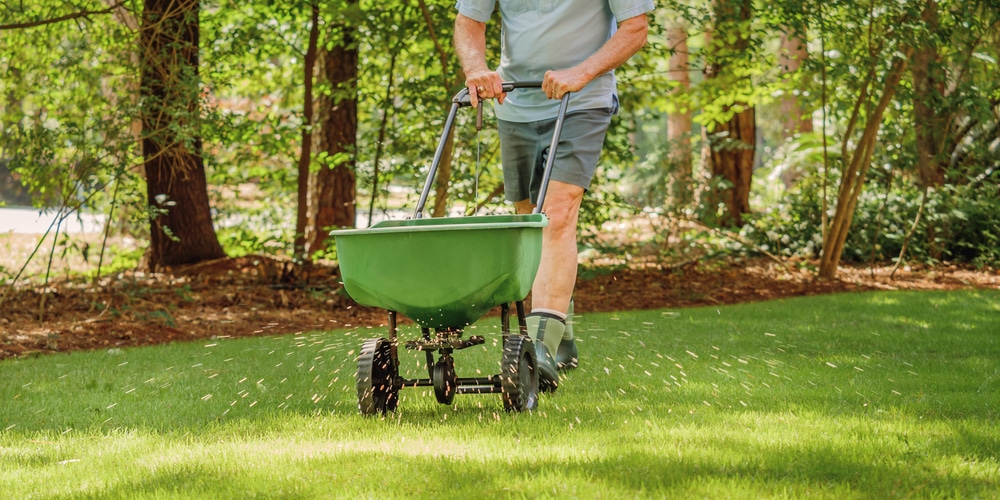Not sure where to start getting your lawn ready for spring? Don’t worry, we’ve got you covered! Let’s get straight to it.
Evaluate Your Lawn
As spring emerges, your lawn is eager to shake off the winter chill. Begin by conducting a thorough assessment. Here’s a quick guide:
- Visual Inspection: Take a walk around your lawn. Look for areas of discoloration, bare patches, or signs of pest activity that may require attention.
- Soil Moisture: Check the soil’s moisture levels by grabbing a handful. It should feel damp, not saturated.
Grass Blades:
- Healthy: uniform green color, resilient when walked on.
- Unhealthy: discolored, wilted, or flat.
Thatch: Scratch a small area gently to evaluate thatch buildup. A thatch layer thicker than half an inch can impede water and nutrient penetration.
Soil Compaction Test: Try pushing a screwdriver into the soil. A hard resistance may suggest compaction, signaling that aeration might be beneficial.
Identify Weeds: Spotting weeds early can help you plan for targeted weed control strategies.
Pest Damage: Look for evidence of insects or rodent damage. Small holes or chewed grass blades often point to an issue that needs to be addressed.
Spring Lawn Cleanup
As the snow melts and the days get longer, it’s time to gear up for spring lawn cleanup. This essential task sets the stage for a healthy lawn throughout the warmer months, focusing on removing debris and taking steps to control weeds.
Debris Removal
Start your spring lawn care with a thorough debris removal process. During the winter, various items can accumulate on your lawn, including:
- Fallen branches
- Leaves
- Thatch
Removing these items can prevent mold growth and ensure that your lawn’s soil isn’t suffocated. As recommended by The Spruce, raking deeply to remove thatch can also help to aerate the soil, providing the perfect environment for new grass to flourish.
Weed Control
Early spring is an ideal time for weed control. Here’s a strategic approach:
- Identify common weeds in your area to tailor your approach.
- Apply pre-emergent herbicides to stop weeds before they start, as highlighted by Popular Mechanics, ideally when the soil temperature reaches about 52 degrees Fahrenheit.
- For existing weeds, spot-treating with the appropriate herbicide can effectively target problem areas without affecting the surrounding grass.
Lawn Repair
Spring signals the time for rejuvenating your lawn after the winter slumber. Proper lawn repair steps, notably aeration and overseeding, are critical to revitalize your turf and ensure robust growth.
Aeration
Aeration is a process that creates small holes in your lawn to allow air, water, and nutrients to penetrate the grass roots. This helps to:
- Alleviate soil compaction: Compacted soil can hinder root expansion and water infiltration.
- Enhance root growth: With more space, roots can spread out to absorb more nutrients and water.
When to aerate:
Ideally, aerate your lawn in early spring or fall, when your grass is in its peak growing phase.
Overseeding
Overseeding involves planting new grass seed to fill in bare or thin spots in your lawn. This process enhances lawn density and introduces more resilient grass varieties. Steps for overseeding include:
- Choose the right seed: Select a grass type compatible with your climate and existing lawn.
- Prepare the area: Rake to remove dead grass and loosen the soil, ensuring seed-to-soil contact.
- Apply the seeds: Use a spreader for even distribution.
- Water regularly: Ensure the seeds receive consistent moisture until they germinate and establish.
Best practice:
Combine overseeding with aeration for the seeds to settle into the holes and develop a strong root system.
Lawn Maintenance
As spring arrives, your lawn requires key maintenance steps to ensure its health and vitality. Adequate fertilization and proper mowing patterns set the stage for a lush, thriving lawn throughout the warmer months.
Fertilization
Fertilizing your lawn in the spring helps jump-start growth by replenishing essential nutrients. Consider the following steps:
- Choose the Right Fertilizer: Select a slow-release spring lawn fertilizer suited to your grass type to provide a balanced supply of nutrients like nitrogen, phosphorus, and potassium.
- Apply Fertilizer Evenly: Use a spreader to ensure even distribution, as uneven application can lead to patchy growth. The addition of a slow-release spring lawn fertilizer can encourage a robust lawn.
Mowing Patterns
Adopting the correct mowing patterns is crucial for encouraging a healthy lawn:
- Height Adjustment: Keep blades high during early spring to avoid cutting grass too short, which can stress it and lead to weed invasion.
- Change Directions: Alternate your mowing pattern with each cut to avoid compacting the soil and to help grass blades stand up straight for a consistent look.
Frequently Asked Questions
As you bid farewell to winter, your lawn requires attention to bounce back into its lush, green state. These questions will guide you through smart practices for rejuvenating your lawn after the cold months.
What should you do first to prepare your lawn for spring?
Your initial task is to assess your yard for damage and debris. Remove any twigs, leaves, or rubbish that have accumulated. This cleanup allows sunlight and air to reach the soil, creating a healthier environment for new grass growth.
When is the optimal time to start a spring lawn care routine?
The best time to start your spring lawn care is when the soil temperature reaches about 55 degrees Fahrenheit consistently. This is typically when you’ll notice the first lawn weeds, like crabgrass, begin to sprout.
What are the essential steps for prepping a lawn for spring during the fall?
- Aerate the soil to improve oxygen circulation.
- Overseed to encourage thick, robust growth, which in turn prevents weeds.
- Apply a winterizing fertilizer to support root growth through winter.
Can you provide a DIY lawn care schedule for the spring season?
Certainly, your DIY lawn care schedule should include:
- Early spring: Cleanup and light raking, followed by fertilizer application when grass begins active growth.
- Mid-spring: Broadleaf weed control, ideally when weeds are young.
- Late spring: Mow regularly at the recommended height for your grass type.
What are the top spring lawn fertilizer recommendations?
Choose a slow-release nitrogen fertilizer for steady growth. Additionally, ensure the product matches the nutrient needs of your lawn, which can be determined by a soil test.
How do I revive my lawn in the spring after winter dormancy?
Begin by raking gently to remove thatch and aerate compact soil. Then, reseed bare spots. Consider a balanced fertilizer to give your lawn a nutritional boost.
Regular, early morning watering can help establish newly germinated seeds.
Last update on 2024-04-29 / Affiliate links / Images from Amazon Product Advertising API




